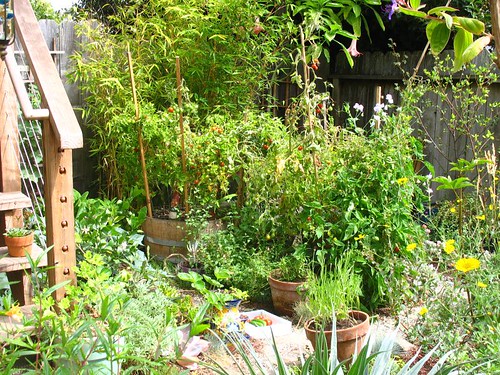
I have two half-barrels of tomato plants. The harvest started in mid-June, and I expect the season to run through October. But the plants are looking shabby (as in shabby, not shabby-chic). I'm glad I have two barrels, because the time has come for one of them to go.
I expected the roots to be more extensive than this.

I actually have a minor redesign in mind. I removed the Fremontodendron from the big blue container it hated, and I moved the container into the vegetable garden where I'll use it for vegetables--effectively a raised-bed without the trouble of bed-raising.

Also in that container was tough, small, native perennial mallow Sidalcea malviflora, common name Checkerbloom.
It spreads by long, deep runners like this.
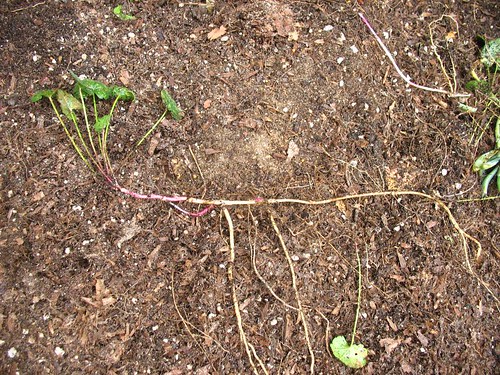
Like all mallows, it's very difficult to dig up--much tougher than the shrubby Fremontodendron! But I have a whole bucket full of healthy checkerbloom divisions to distribute around the garden.
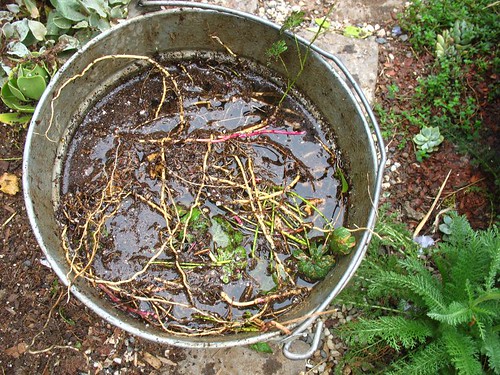
I'm also moving the garden path from here...
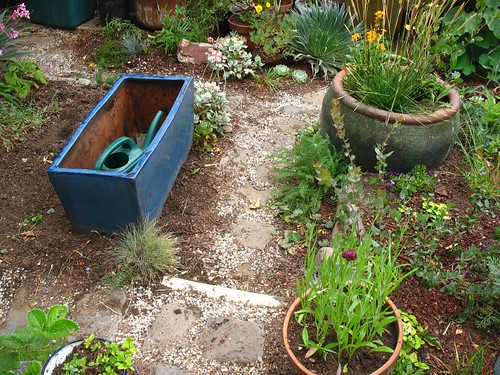
To here:
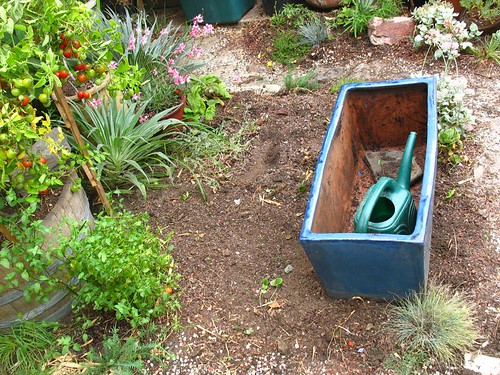
This will accomplish two things. First, making a circuit through the garden will now require a walk through the vegetable garden instead of around it. Second, it gives a manzanita you really can't see in this picture more room to grow. More on that later.
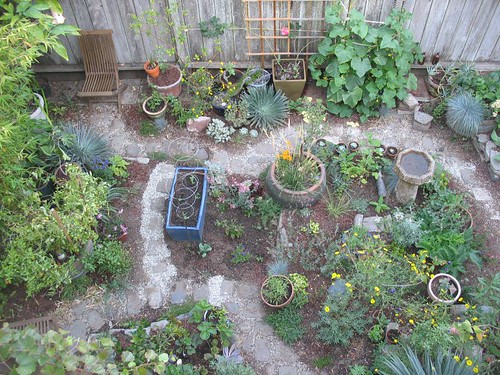
(The garden is still mostly soil! Next year...always next year...)
Removing one of the tomato barrels also revealed a previously obscured Echium wildprettii (the one on the left).

The Ficus carica 'Brown Turkey' is new to the garden. I bought that a couple weeks ago during a spontaneous, mid-week run up to California Flora after work. They had 1-gallon figs on clearance. My favorite way to shop.
This blue spires is new too. I've already forgotten what it is, but I'm sure you can tell me.
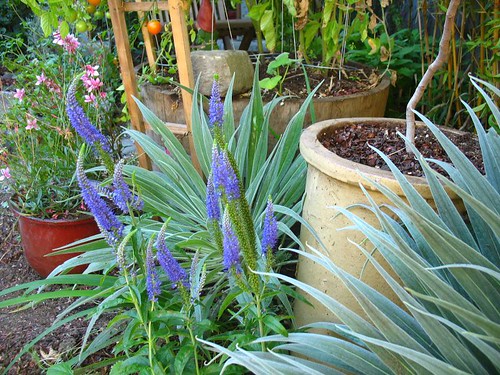
(The other day, I did something I've never done before. I checked out the back area of nursery I shop at most often to see what plants they were holding for local professionals. I liked three plants I saw back there that I never would have bought myself. The nursery more of them for sale, and I bought all three. Blue spires was one of those three--see the other two later.)
Another thing I did was remove my one remainging Datura wrightii. I think we've enjoyed this flower enough for 2007.
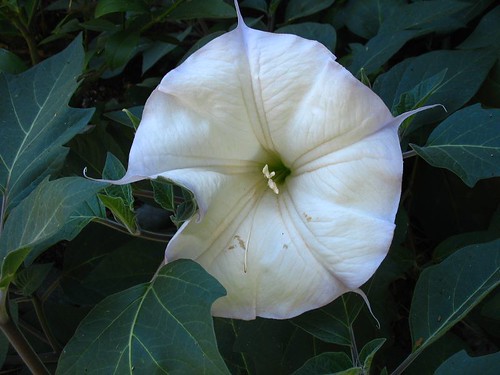
It's getting so big, I can't deal with it anymore. The coveted thorny seedball will have to wait until next year when I'll grow this plant in a container instead of in the ground. I'm changing it out for the Silver Bush Lupine I brought down from the roof garden.
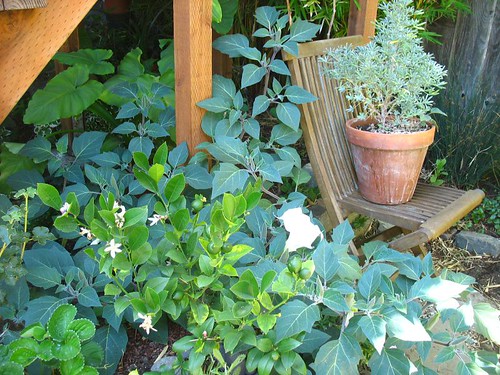
I dressed up to extirpate the possibly quite poisonous (but probably not through simple skin contact) Jimson Weed.
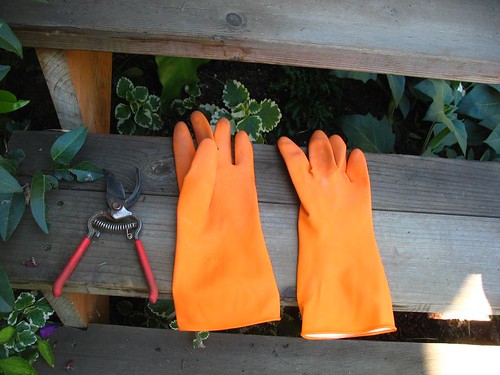
And I had to smash the pot with a hammer to get my hands on the lupine. So glad I put the lupine in a terracotta pot and not a nice glazed pot!

The lupine bookends the Meyer lemon with the silver/gray so common in California garden color schemes; the other bookend is native buckwheat Eriogonum arborescens.
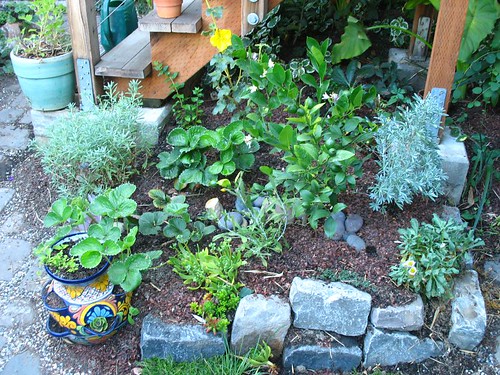
The yellow flower behind it all is my new, naturally two-dimensional Fremontodendron 'San Gabriel' to replace the one I had to remove from the big blue container. I've waited to institute this plan for several months. So glad it's done!
Come back later for a little tour of the garden--right now, dinner's on!

7 comments:
I like seeing the second-story view of your garden. A literal overview. What are those spiky, blue, round plants scattered through your garden? Some sort of aloe? I love their shape and color.
That's the Echium wildprettii, a biennial from the Boraginaceae. I'm going to talk about it more in my next post.
I think your Blue Spires in between the Echiums might be a Speedwell, a Veronica sp.
It is raining raining today. Not a good time to go buy more bags of concrete and bring them home in my truck.
Veronica, yes. Thank you, Christopher.
Nice changes!
"Spike" Speedwell is a favorite in my garden, Chuck. Even when it's past its prime, there's enough of a blue haze that I don't cut it back till it's really ratty.
I hate to say this, but your lupine is going to get about 3-6 feet tall and wide, and can even get bigger.
Post a Comment